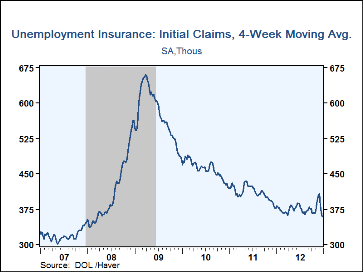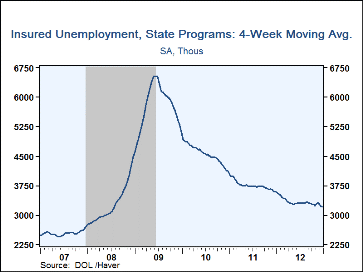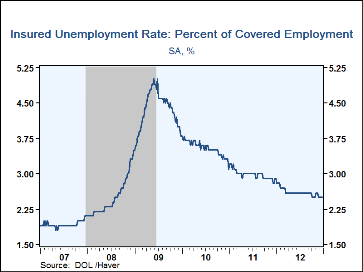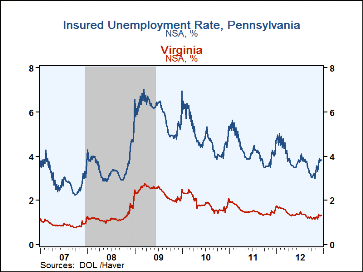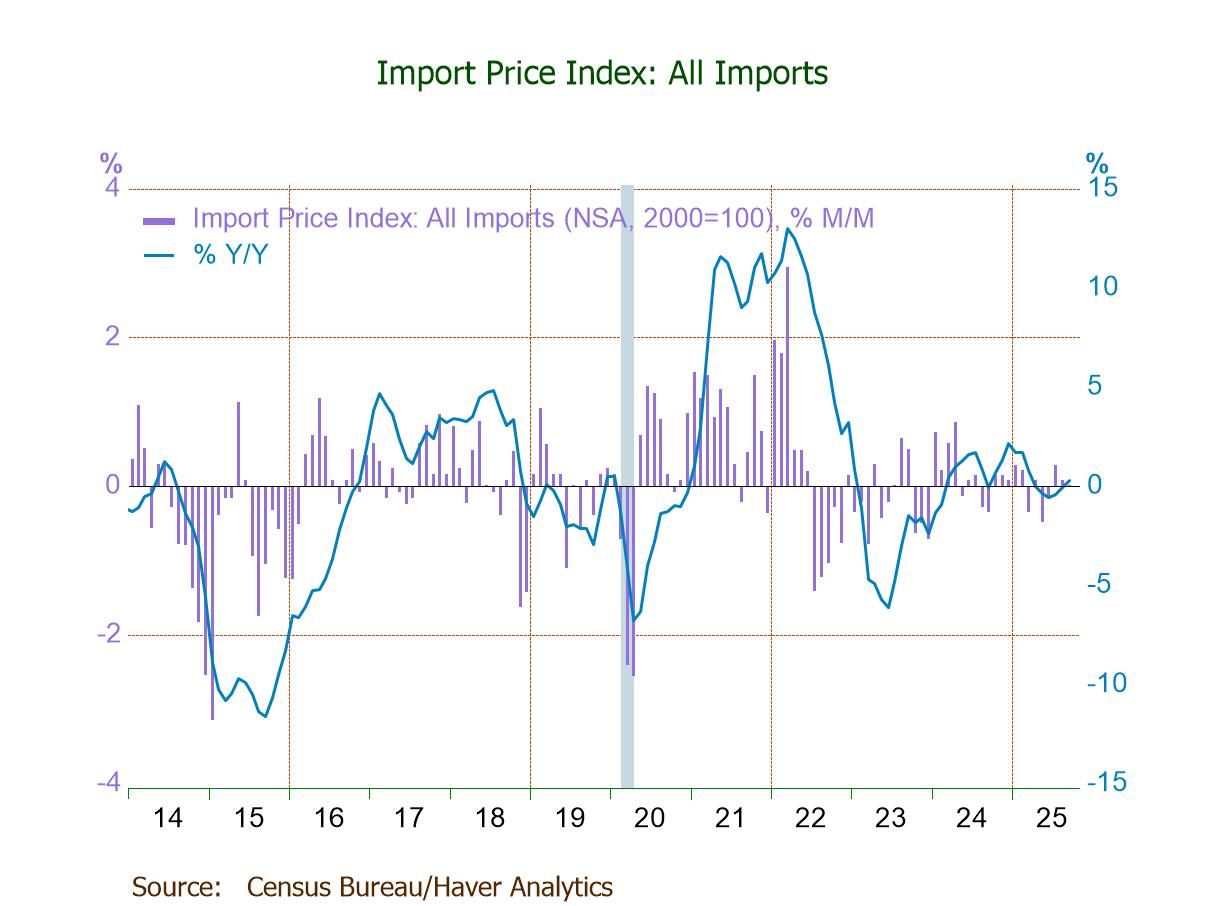 Global| Jan 03 2013
Global| Jan 03 2013U.S. Initial Jobless Insurance Claims Move Slightly Higher
by:Tom Moeller
|in:Economy in Brief
Summary
Initial claims for unemployment insurance rose to 372,000 (2.8% y/y) during the week ended December 29 from 362,000 during the week prior, revised from 350,000. Consensus expectations were for 355,000 claims. The four week moving [...]
Initial claims for unemployment insurance rose to 372,000 (2.8% y/y) during the week ended December 29 from 362,000 during the week prior, revised from 350,000. Consensus expectations were for 355,000 claims. The four week moving average of claims was essentially unchanged at 360,000. During the last ten years there has been a 75% correlation between the level of claims and the m/m chance in nonfarm payrolls.
Continuing claims for unemployment insurance in the week ended December 22 increased to 3.245M (-10% y/y). The insured rate of unemployment held at 2.5% for the fifth consecutive week. This particular count covers only "regular" programs and does not include all extended benefit and other specialized jobless insurance programs. In the week of December 15, the latest figure available, the grand total of all benefit recipients slipped to 5.403M. This was still down nearly one-quarter, more specifically, 25.2%, from a year ago, and compares to a cycle peak of 12.060M in January 2010.
By state, the insured unemployment rate continued to vary greatly with Virginia (1.33%), Texas (1.57), Florida (1.67%), Tennessee (1.71%), Indiana (1.84%), Ohio (2.05%) and Michigan (2.84%) at the low end of the range. At the high end were New York (2.95%), Massachusetts (3.08%), Illinois (3.24%), Connecticut (3.29%), California (3.39%), New Jersey (3.78%) and Pennsylvania (3.81%).
Data on weekly unemployment insurance programs are contained in Haver's WEEKLY database, including the seasonal factor series, and they are summarized monthly in USECON. Data for individual states, including the unemployment rates that determine individual state eligibility for the extended benefits programs and specific "tiers" of the emergency program, are in REGIONW, a database of weekly data for states and various regional divisions. Note that the Labor Department reports individual state data and the extended benefit program data with a one-week lag compared to the "regular program" national totals. The consensus estimates come from the Action Economics survey, carried in the AS1REPNA database.
Falling Off the Fiscal Cliff from the Federal Reserve Bank of Dallas can be found here.
| Unemployment Insurance (000s) | 12/29/12 | 12/22/12 | 12/15/12 | Y/Y % | 2012 | 2011 | 2010 |
|---|---|---|---|---|---|---|---|
| Initial Claims | 372 | 362 | 362 | 2.8 | 375 | 409 | 459 |
| Continuing Claims | -- | 3,245 | 3,201 | -10.0 | -- | 3,745 | 4,544 |
| Insured Unemployment Rate (%) | -- | 2.5 | 2.5 | 2.9 (12/11) |
-- | 3.0 | 3.6 |
| Total "All Programs" (NSA) | -- | -- | 5.403M | -25.2 | -- | 7.750M | 9.850M |
Tom Moeller
AuthorMore in Author Profile »Prior to joining Haver Analytics in 2000, Mr. Moeller worked as the Economist at Chancellor Capital Management from 1985 to 1999. There, he developed comprehensive economic forecasts and interpreted economic data for equity and fixed income portfolio managers. Also at Chancellor, Mr. Moeller worked as an equity analyst and was responsible for researching and rating companies in the economically sensitive automobile and housing industries for investment in Chancellor’s equity portfolio. Prior to joining Chancellor, Mr. Moeller was an Economist at Citibank from 1979 to 1984. He also analyzed pricing behavior in the metals industry for the Council on Wage and Price Stability in Washington, D.C. In 1999, Mr. Moeller received the award for most accurate forecast from the Forecasters' Club of New York. From 1990 to 1992 he was President of the New York Association for Business Economists. Mr. Moeller earned an M.B.A. in Finance from Fordham University, where he graduated in 1987. He holds a Bachelor of Arts in Economics from George Washington University.


